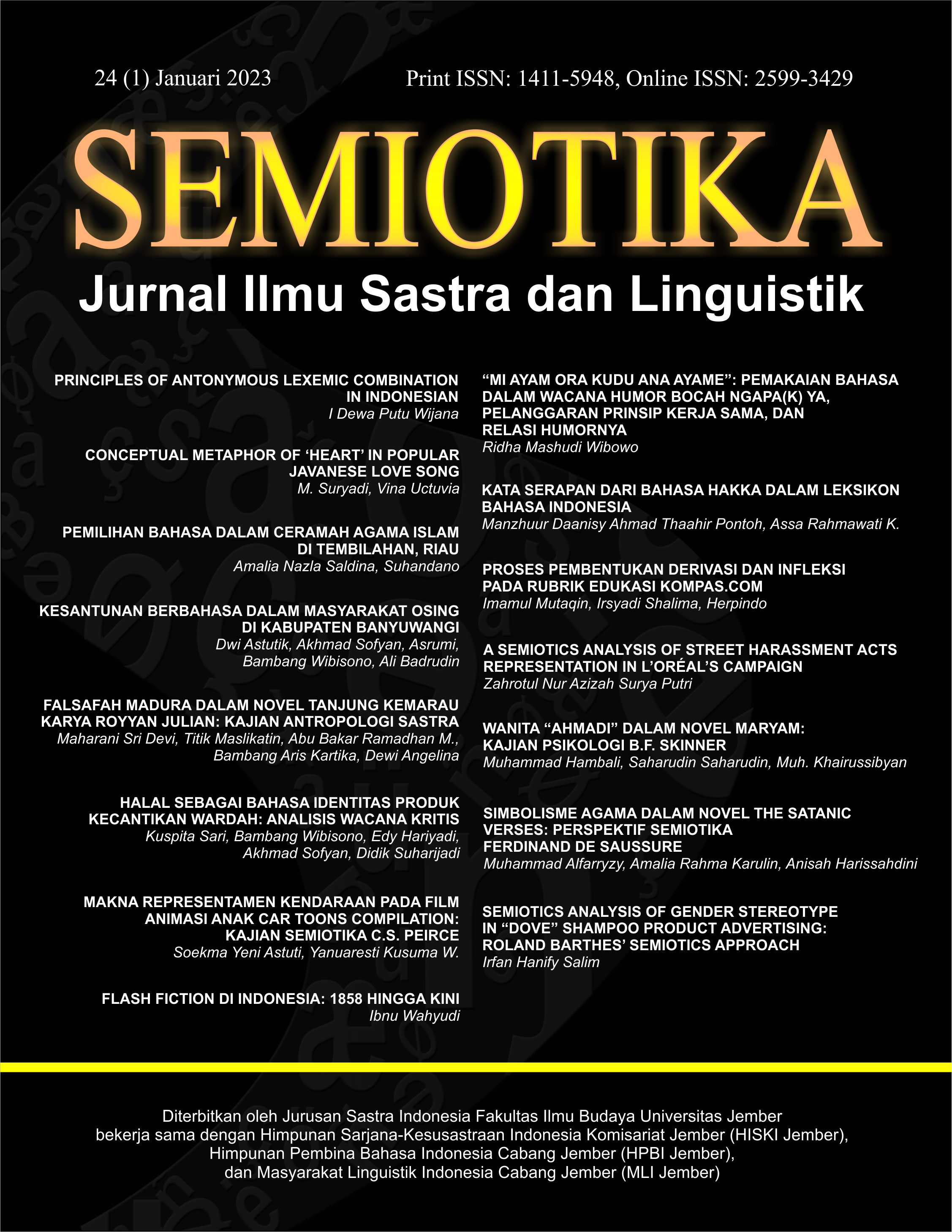PROSES PEMBENTUKAN DERIVASI DAN INFLEKSI PADA RUBRIK EDUKASI KOMPAS.COM
DOI:
https://doi.org/10.19184/semiotika.v24i1.31455Keywords:
affixation, derivation, inflection, Kompas.com educational rubricAbstract
The word formation process is inseparable from the morphological process of affixation. The formation of verb word classes can be derived from verb, noun, adjective, and adverb word classes. This phenomenon causes morphological symptoms of derivation and inflection. Derivation is the process of forming new words that cause changes in lexical identity, while inflection does not change lexical identity. This study aims to obtain a description of the process of forming derivation words and forming inflected words on Kompas.com. Research using qualitative methods. The data and data sources used are online news Kompas.com, the January 2022 edition of the education rubric. The analysis technique used in analyzing the data uses the distribution method with the direct element division technique. The results of this study found words that experienced derivation and inflection with various kinds of forming affixes. Derivative and inflected affixes in Kompas.com consist of prefixes, suffixes, confixes and combinations of affixes. Initial prefixes or affixes are in the form of meN-, di-, ke-, ber-, ter, se-, and peN-; suffixes or final affixes consist of -an, -i, and -kan; confix affixes have forms of ke-an, penN-an, per-an, and beran; as well as combinations of affixes consisting of the forms of memper-/-kan, meN- -i, di-/-i, meN-/-kan, di-/-kan, diper-/-kan, and diper-/-i. The phenomenon of the affix meN- is an affix that forms an active verb, while the affix di- forms a passive verb. Also found ter- and ke-an affixes which are affixes forming anti-passive ergative verbs. Based on the productivity aspect, inflection is more productive than derivation.
Downloads
References
Gorontalo. Ideas: Jurnal Pendidikan, Sosial, dan Budaya, 6(4):397.
https://doi.org/10.32884/ideas.v6i4.305
Alieva, N.F. et.al. 1991. Bahasa Indonesia: Deskripsi dan Teori. Yogyakarta: Kanisius.
Anggraini, A. S. 2019. Pembentukan Verba Deadjektiva dalam Media Cetak Kompas
Berdasarkan Perspektif Derivasi dan Infleksi.
Bagiya, B. 2017. Infleksi dan Derivasi dalam Bahasa Indonesia. Journal of Language
Learning and Research (JOLLAR), 1(1):32–40.
https://doi.org/10.22236/jollar.v1i1.1240
Bauer, L. 1988. Introducing Linguistic Morphology. in Edinburgh University Press.
Edinburgh University. https://doi.org/10.1353/lan.2005.0069
Booij, G. 2010. Gramatika Kata. Cerdas Press.
Cahya, I. S. 2018. Menulis Berita di Media Massa. Yogyakarta: Pustaka Belajar.
Ermanto, E. 2008. Perspektif Morfologi Derivasional dan Infleksional pada Verba Berafiks
Bahasa Indonesia. Kajian Linguistik dan Sastra, 20(1):24–37.
https://doi.org/10.31227/osf.io/m3avw
Ermanto, E. 2016. Proses Morfologi Infleksi pada Adjektiva Bahasa Indonesia. Humanus,
12(2), 41. https://doi.org/10.24036/jh.v15i1.6411
Fokker, A. A., & Smolikowska, E. 2018. Anatomy of A Word-class: A Chapter of Polish
Grammar. Walter de Gruyter GmbH & Co KG., 254.
Haspelmath, M. 2002. Understanding Morphology. Oxford University.
Herpindo, H., Wijayanti, A., Shalima, I., & Ngestrini, R. 2022. Kategori, Fungsi, dan Peran
Sintaksis Bahasa Indonesia dengan pos Tagging Berbasis Rule dan Probability.
KEMBARA: Jurnal Keilmuan Bahasa, Sastra, Dan Pengajarannya.
Katamba, F. 1994. Morphology. The Macmilian Press Ltd.
Keraf, G. 1980. Komposisi: Sebuah Pengantar Kemahiran Berbahasa. Ende: Nusa Indah.
Kridalaksana, H. 1996. Pembentukan Kata dalam Bahasa Indonesia. Jakarta: Gramedia.
Kridalaksana, H. 2007. Pembentukan Kata dalam Bahasa indonesia. Jakarta: Gramedia.
Kusumaningrat, H. 2019. Jurnalistik Teori dan Praktik. Bandung: PT Remaja Rosdakarya.
Mahsun. 2017. Metode Penelitian Bahasa. Jakarta: Rajawali Press.
Mata, T. W. 2021. Derivasi dan Infleksi dalam Bahasa Sabu pada Masyarakat Depe
Kecamatan Sabu Barat Kabupaten Sabu Raijua (Doctoral Dissertation, Universitas
Flores).
Nida, E. . 1949. Morphology: the Descriptive Analysis of Words. The University of Michigan
Press.
Parera, J. . 2007. Morfologi Bahasa. Jakarta: Gramedia Pustaka.
Ramlan, M. (2009). Morfologi Suatu Tinjauan Bahasa. Karyono.
Romli, D. 2016. Jurnalistik Praktis untuk Pemula. Bandung: PT Remaja Rosdakarya.
Scalise, S. 1984. Generative Morphology. Foris Publications.
Setyaningsih, I. 2019. Intisari Morfologi, Afiksasi, Reduplikasi, dan Komposisi. Pakar Karya.
Similarweb. (n.d.). (n.d.). Kompas.com Traffic Analytics & Market Share. Retrieved February
16, 2022, from https://www.similarweb.com/website/kompas.com/#overview
Subroto, et.al,. 1985. Infleksi dan Derivasi (Kemungkinan Penerapannya dalam Pemerian
Morfologi Bahasa Indonesia). Yogyakarta: Universitas Sarjanawiyata Taman Siswa.
Sudaryanto. 1998. Metode Linguistik, Bagian Pertama: ke Arah Memahami Metode
Linguistik. Yogyakarta: Gadjah Mada University Press.
Sudaryanto. 2015. Metode dan Aneka Teknik Analisis Bahasa. Yogyakarta: Sanata Dharma
University Press.
Verhaar, J. W. . 1984. Pengantar Linguistik. Yogyakarta: Gadjah Mada University Press.
Verhaar, J. W. M. 1999. Asas-asas Linguistik Umum. Yogyakarta: Gadjah Mada University
Press.
Walidin, et.al,. 2015. Metodologi Penelitian Kualitatif & Grounded Theory. FTK Ar-Raniry
Press.
Yunus, S. 2012. Jurnalistik Terapan. Ghalia Indonesia.
Yusuf, C. 2008. Morfologi Bahasa Indonesia. Bandung Institude.
Zuhro, F. 2020. Proses Derivasi dan Infleksi dalam Bahasa Indonesia pada Berita Koran Jawa
Pos Radar Jombang Edisi Juli 2019. Jurnal Disastri (Jurnal Pendidikan Bahasa dan
Sastra Indonesia), 2(1):1–8. https://doi.org/10.33752/disastri.v2i1.872
Downloads
Published
Issue
Section
License
SEMIOTIKA has CC-BY-SA or an equivalent license as the optimal license for the publication, distribution, use, and reuse of scholarly work. Authors who publish with this journal retain copyright and grant the journal right of first publication with the work simultaneously licensed under a Creative Commons Attribution-ShareAlike 4.0 International License that allows others to share the work with an acknowledgment of the work's authorship and initial publication in this journal.
Attribution-ShareAlike
CC BY-SA


